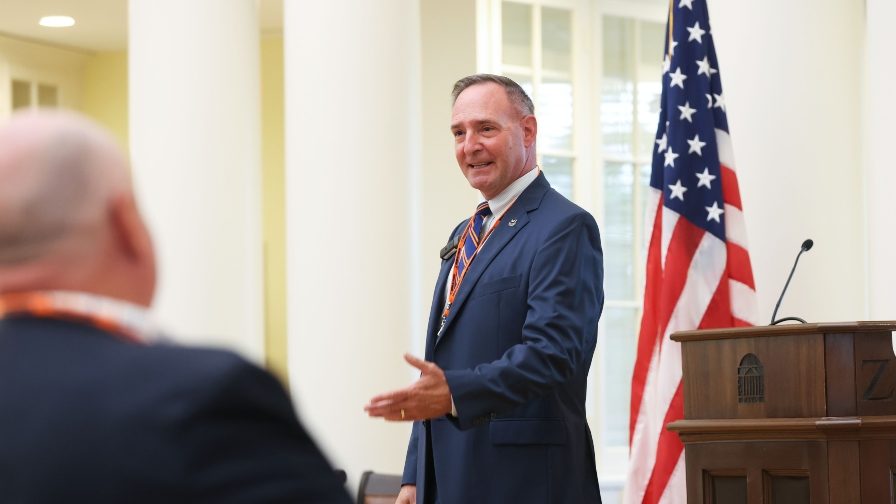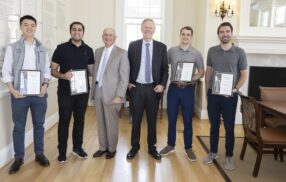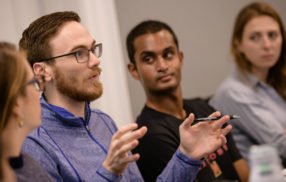
The Future of Work and Communicating in Times of Chaos: Insights From the Darden Leadership Communication Council
By Dave Hendrick
The tumultuous events of recent years, from social unrest in U.S. cities to nuclear brinksmanship on the Korean peninsula and especially the ongoing COVID-19 pandemic, have been described ad nauseam with a single descriptor: unprecedented.
Speaking at the fifth annual meeting of the University of Virginia Darden School of Business Leadership Communication Council at the keynote James Rubin Dialogue, Lieutenant General Charles Pede, the recently retired Judge Advocate General of the United States Army, said the use of the term suggested an inability to grapple with, and contextualize, historical events.
“All good leaders have particular influence in reminding people that there is not a lot that is unprecedented,” said Pede, who holds undergraduate and law degrees from UVA. “If you dig at all, you realize that what we are experiencing probably has happened before in some variety.”
The ability to draw upon and learn from historical precedent is a key trait for effective leaders and communicators helping their teams make sense of circumstances that can seem without precedent.
Speaking at the Rotunda, Pede detailed his experience leading a team of 10,000 legal professionals as the Judge Advocate General and the changes and impact he sought to bring about during his four-year tenure. Some initiatives were subtle; in an effort to encourage those in his organization to think of themselves as lawyers first, he began to refer to the JAG Corps as “the law firm,” for instance.
“For four years, I persistently referred to [the JAG Corps] as a law firm. The sole reason was to remind [Judge Advocates] that their first mission set was the practice of law,” said Pede, calling the effort an exercise in the “power of word choice.”
Pede spoke of the challenges of indoctrinating new law professionals into a large, global organization, and called his 2018 article on “principled lawyering” in The Army Lawyer an attempt to communicate bedrock virtues to the broader organization. A steady drumbeat of communication is important when communicating a message, Pede said, and, importantly, one must be confident in the “content of the drumbeat.”
Pede, who also discussed avoiding insularity of thought in the top ranks and building a culture that encourages speaking truth to the powerful, offered the following reminder of the role of words setting direction and driving momentum: “Leadership is communication, and communication is leadership.”
Following Pede’s keynote, communication leaders and executives explored the altered landscape across a day of Leadership Communication Council programming focused on topics ranging from the future of work to social media measurement to tapping corporate archives for messaging potential, among other topics.
CEO Communication Shifts to Meet the Moment
At a panel discussion on CEO communication, Gregg Schmidt, chief communications officer for Corteva Agriscience, said the pandemic changed the format and cadence of both internal and external communications. Internally, that often meant a steady string of video communications from CEO Jim Collins to the company’s 20,000 employees around the world, often communicating on matters focused on COVID-19, safety and health. For the company’s global sales force, the changed landscape often involved learning how the customer wished to be communicated with, which could involve a salesperson conversing with a farmer outside at a safe distance, for instance.
“We have tried to maintain that close customer relationship through the whole pandemic and to ensure the customer [is engaged with us] the way they want,” said Schmidt.
Indeed, Steve Soltis, who in addition to leading courses at the Darden School as a lecturer and executive-in-residence serves as a senior advisor at Mas Leadership Communication, said one pattern he’s observed over the course of the past year and a half is the COVID-driven evolution from intense employee communication beginning in March 2020, to customer communication, and now supply chain and Wall Street communication.
“There has been great learning and innovation in the past 18 months, so now a lot of the communication for the CEOs I’m working with involves articulating the business strategy and operational resilience strategy and strategic pivots the business is making,” said Soltis. “It’s an incredibly important message for Wall Street. [Investor relations] as a stakeholder group has never been more important.”
CNBC producer Stephanie Dhue (EMBA ’21) said the message of how companies are pivoting and “what they are doing that is new and different” remains a leading topic. The news business has also seen remarkable evolution over the course of the pandemic.
“The speed of communication is much quicker,” said Dhue, noting that once laborious live TV interviews now sometimes involve little more than a source appearing via Zoom. “COVID really changed and sped up the communications world.”
Workplace Disruption Leads to the ‘Hybrid Paradox’
Also changed, of course, the nature and location of work itself.
At a panel considering the future of work, experts working in technology, corporate real estate and design noted the spectrum of work policies in the wake of COVID-19, ranging from total flexibility to a complete return to the pre-pandemic office-based work.
“There is no one answer,” said Julie Seitz, client strategy director at Gensler, the global architecture, design and planning firm. “We don’t know what the future is going to be around hybrid. A lot of companies are experimenting, which is exactly what they should be doing right now — flexibility is the key.”
Seitz said it was a “myth” that companies were selling their office space in favor of a hybrid or work-from-home future, but companies of all sizes are considering geographic location and site selection in new ways.
Desmond Dickerson, director of Future of Work at Microsoft, agreed that the global workforce was in a period of massive experimentation, one in which few have landed on true success. Some solutions may work for certain teams and demographics but translate poorly to others, he said.
Dickerson further noted recent Microsoft research pointing to what he called “the hybrid paradox,” in which strong majorities of surveyed respondents want both total flexibility and the ability to work where they want, and yet simultaneously claim to miss working in the office. Dickerson summed up the sentiment as: “I want to go do my thing, but I also miss my team.”
Prevailing attitudes toward the future of work break down in unexpected demographic terms, as well, and Dickerson noted the surprising degree to which younger demographics — often considered digital natives most comfortable with a tech-focused future — are “struggling” with remote work.
The Microsoft executive said the youngest members of the workforce often lack the environmental comforts of their older colleagues — they may live in apartments or houses with multiple roommates, for instance — and often do not have established networks to turn to for advice and camaraderie.
“Some of the data we have suggests more interaction [in a remote environment],” said Dickerson. “The problem is those strong ties are strengthening and the weak ties are weakening.”
One of the potentially enduring bright spots of remote work, according to Jennifer Kolstad, global design director of environments at Ford Motor Co., involves offering more workers “equal access to productivity” and enabling those who left or were never able to join the workforce the ability to reach their full potential.
Indeed, Dickerson said executive and managers should view “the great reset” as an opportunity to consider how to achieve greater gender parity and bring in more diverse populations.
Leadership Communication Council Aims to Inform, Make Darden Offerings Paramount
The Darden Leadership Communication Council, which is led by Professor June West and Soltis, includes leading communication professionals and academics who regularly share best practices and advise the Darden School as it aims to offer an unmatched communication program. The council’s work has spurred two new elective courses at Darden. Council members have regularly served as guest lecturers in Darden courses, helped craft new case studies, and served as partners and mentors for multiple Darden students.
“We know that the leadership competency of effective communication has never been more important,” said West. “We are thrilled with the accomplishments and evolution of the council, and remain grateful for their support and expertise as we seek to make Darden the home of the best communication program in the world.”
The University of Virginia Darden School of Business prepares responsible global leaders through unparalleled transformational learning experiences. Darden’s graduate degree programs (MBA, MSBA and Ph.D.) and Executive Education & Lifelong Learning programs offered by the Darden School Foundation set the stage for a lifetime of career advancement and impact. Darden’s top-ranked faculty, renowned for teaching excellence, inspires and shapes modern business leadership worldwide through research, thought leadership and business publishing. Darden has Grounds in Charlottesville, Virginia, and the Washington, D.C., area and a global community that includes 18,000 alumni in 90 countries. Darden was established in 1955 at the University of Virginia, a top public university founded by Thomas Jefferson in 1819 in Charlottesville, Virginia.
Press Contact
Molly Mitchell
Associate Director of Content Marketing and Social Media
Darden School of Business
University of Virginia
MitchellM@darden.virginia.edu









